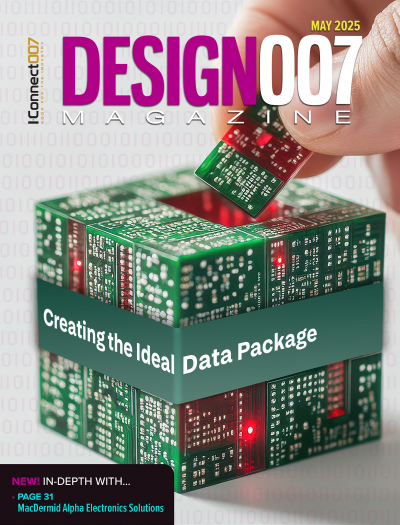-

- News
- Books
Featured Books
- design007 Magazine
Latest Issues
Current Issue
Showing Some Constraint
A strong design constraint strategy carefully balances a wide range of electrical and manufacturing trade-offs. This month, we explore the key requirements, common challenges, and best practices behind building an effective constraint strategy.

All About That Route
Most designers favor manual routing, but today's interactive autorouters may be changing designers' minds by allowing users more direct control. In this issue, our expert contributors discuss a variety of manual and autorouting strategies.

Creating the Ideal Data Package
Why is it so difficult to create the ideal data package? Many of these simple errors can be alleviated by paying attention to detail—and knowing what issues to look out for. So, this month, our experts weigh in on the best practices for creating the ideal design data package for your design.
- Articles
- Columns
- Links
- Media kit
||| MENU - design007 Magazine
High-frequency EMC Noise in DC Circuits
May 29, 2025 | Karen Burnham, EMC UnitedEstimated reading time: 1 minute
EMC isn’t black magic, but it’s easy to understand why it seems that way. When looking at a schematic like that in Figure 1, it looks like you’re only dealing with DC signals all across the board. There’s a 28 VDC input that goes through an EMI filter, then gets converted to 12 VDC power. Except in extremely rare circumstances involving equipment sensitive to magnetostatic fields, DC electricity will never be part of an EMC problem.
Figure 1: Power conversion stage of avionics unit
Harmonics
The biggest problem occurs when you use a switching operation to convert power from one form to another—something most modern electronics do all the time. For power and thermal efficiency reasons, we want switching waveforms to get as close to a perfect square wave as possible—the faster the rise and fall time, the less loss and heating you have in the operation. The problem is that there’s a trade-off: Faster rise and fall times necessarily generate high-frequency electrical signals. Then, if provisions aren’t made for controlling the high-frequency noise signals, they can escape to cause signal integrity and EMC problems throughout the board and system.
Let’s illustrate this with a simple function generator. The beginning setting is a 5 VDC square wave switching at 20 MHz—something you might see from a board’s clock signal. In Figure 2, we see a cable connected to the function generator channel 1 output. That’s the default cable that came with the function generator, with current being run through a 50 Ω resistor between the red and black leads.
To read the entire article, which originally appeared in the May 2025 issue of Design007 Magazine, click here.
Suggested Items
IBM Power11 Raises the Bar for Enterprise IT
07/10/2025 | IBMIBM revealed IBM Power11, the next generation of IBM® Power® servers. Redesigned with innovations across its processor, hardware architecture, and virtualization software stack, Power11 is designed to deliver the availability, resiliency, performance, and scalability enterprises demand, for seamless hybrid deployment on-premises or in IBM Cloud.
Infineon Advances on 300-millimeter GaN Manufacturing Roadmap as Leading Integrated Device Manufacturer (IDM)
07/10/2025 | InfineonAs the demand for gallium nitride (GaN) semiconductors continues to grow, Infineon Technologies AG is poised to capitalize on this trend and solidify its position as a leading Integrated Device Manufacturer (IDM) in the GaN market.
Maxar Awarded Contract by NGA to Deliver Ai-Powered Object Detection Services
07/01/2025 | MaxarMaxar Intelligence, the leading provider of secure, precise geospatial insights, announced that it was awarded Delivery Order 01 under the Luno A program by the National Geospatial-Intelligence Agency (NGA).
Empower Appoints Steve Hertog as Senior Vice President of Sales to Strengthen Next Phase of High Growth
07/01/2025 | Empower SemiconductorEmpower Semiconductor, the world leader in integrated voltage regulators (IVRs), announced the appointment of Steve Hertog as Senior Vice President of Sales. In this role,
OKI, NTT Innovative Devices Establish Mass Production Technology for High-Power Terahertz Devices by Heterogeneous Material Bonding
06/21/2025 | BUSINESS WIREOKI, in collaboration with NTT Innovative Devices Corporation, has established mass production technology for high-power terahertz devices using crystal film bonding (CFB) technology for heterogeneous material bonding to bond indium phosphide (InP)-based uni-traveling carrier photodiodes (UTC-PD) onto silicon carbide (SiC) with excellent heat dissipation characteristics for improved bonding yields.


